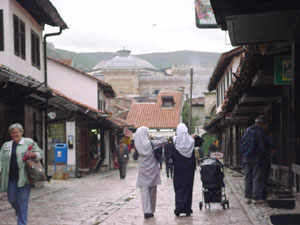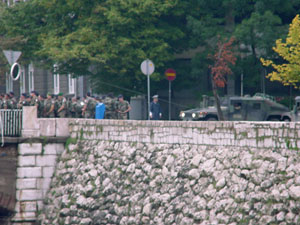![]()
| Bosnia-Herzegovina | Sarajevo | 2002.09.21 - 09.23 |
City with Soul
On arrival to a city, one immediately senses its level of energy. Most cities have a dull mundane quality to them. But every now and then, a vibrant energy is sensed. I would normally call it SPIRIT. A local woman I talked to put it, "Sarajevo has soul." I couldn't agree more.
What makes the soul is difficult to pinpoint. Some of the components are strong personal identities, a will to improve ones life, and the desire to attain something just beyond reach in the near-term. The people are energetic and forward-looking. The only other places we sensed this similar "soul" are Phnom Penh, Istanbul, and to some extent, Varanasi.
Yet Sarajevo also has a dark side. The strength of ethnic identify extends beyond practicing a particular culture. People in Bosnia-Herzegovina in recent history became territorial along ethnic lines. Although most Western media singled out the Bosnian Serbs as the evil forces committing genocide, the fact is, Serbs, Croats, and Muslims all intended to murder each other. Today, 20,000 (scaled down from 50,000) NATO Stabilization Force troops are positioned between ethnic territorial divides. Their objective is to dissuade a new outbreak of war. The time limit on this mandate is indefinite.
The most interesting part of Sarajevo is Baščaršija. Pedestrian-only cobbled walkways meander through religious centers, souvenir shops, and outdoor cafes. You are free to visit any monument that isn't under reconstruction. Women, however, must wear a headscarf to enter a mosque. From the eastern end of Baščaršija, bus 31E goes 15km to the Serb held Sarajevo suburb of Lukavica where buses to Belgrade depart. Tram 1 travels between Baščaršija and the train station / long-distance bus station (for all destinations other than Serb areas). Tram 4 travels between Ilidza at the far west of Sarajevo and the train station. Tram 3 travels between Baščaršija and Ilidza without turning north to the train station. A KM 1.20 ticket is valid for one boarding. A tram or bus transfer requires a second ticket. Transportation police regularly check passengers' tickets. The penalty for riding ticket-less is KM 20. No excuse is accepted.
A remarkably good Italian restaurant worth noting is Bella Italia at Ul Kobanija br, 1. It's 5 minutes walk west of the bridge where Archduke Franz Ferdinand was assassinated and across the river. Try the house wine that comes from Montenegro.
GETTING THERE
Overland, Sarajevo is best reached by bus because all but one of the train lines is still
destroyed. (The only operating train in Bosnia-Herzegovina is between Sarajevo and
Ploče, Croatia.) Daily buses run from the bus station next to the train station
in Sarajevo to Zagreb, Split (7 hours), and Dubrovnik (7 hours) in Croatia. The bus to
Serb areas in Bosnia-Herzegovina and Belgrade, Serbia (9 hours) departs from the Sarajevo
suburb of Lukavica.
 |
Recent Sarajevo history is violent. On this bridge Austrian Archduke Franz Ferdinand and his wife Sophie were assassinated by a Bosnian Serb, ultimately resulting in World War I. More recently between 1992-1995, Bosnian Serb sniper fire and shelling killed over 10,500 residents. |
 |
On the surface, Sarajevo is a quiet pedestrian town of ethnic mix. Though people are gradually relocating to their pre-war homes, blurring territorial ethnic divides, an underlying sense of tension persists. |
 |
Reminders of the Bosnia-Herzegovina civil war are everywhere even though much of the tourist section is repaired. Most residential buildings in the outskirts of Sarajevo and in other towns are riddled with hundreds of bullet indentations. Some houses and apartments remain gutted with black ash. |
 |
For now, a NATO Stabilization Force (SFOR) remains in the country to dissuade further ethnic fighting. On this day, NATO soldiers were on holiday. Hundreds of unarmed military from Spain, Canada, France, Italy, Romania, Germany, and Poland window-shopped and enjoyed the outdoor cafes. |
Copyright © 2000-2002 Wes and Masami Heiser. All rights reserved.